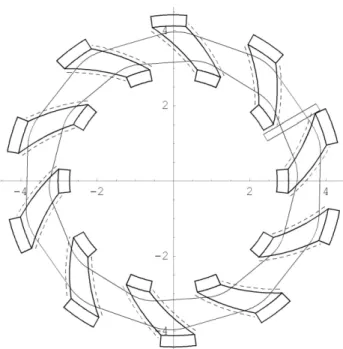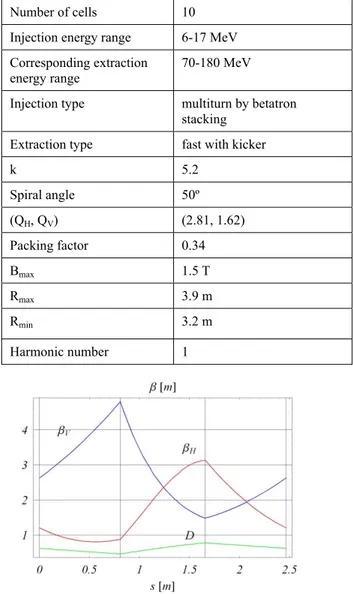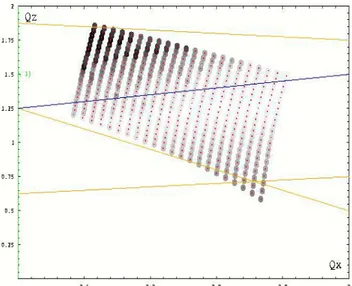HAL Id: in2p3-00169580
http://hal.in2p3.fr/in2p3-00169580
Submitted on 4 Sep 2007HAL is a multi-disciplinary open access
archive for the deposit and dissemination of sci-entific research documents, whether they are pub-lished or not. The documents may come from teaching and research institutions in France or abroad, or from public or private research centers.
L’archive ouverte pluridisciplinaire HAL, est destinée au dépôt et à la diffusion de documents scientifiques de niveau recherche, publiés ou non, émanant des établissements d’enseignement et de recherche français ou étrangers, des laboratoires publics ou privés.
Spiral FFAG for protontherapy
J. Pasternak, J. Fourrier, E. Froidefond, B. Autin, F. Méot, D. Neuvéglise, T.
Planche
To cite this version:
J. Pasternak, J. Fourrier, E. Froidefond, B. Autin, F. Méot, et al.. Spiral FFAG for protontherapy. 22nd Particle Accelerator Conference (PAC’07), 2007, Albuquerque, New Mexico, United States. Joint Accelerator Conferences Website; IEEE, pp.1404-1406, 2007. �in2p3-00169580�
SPIRAL FFAG FOR PROTONTHERAPY*
J. Pasternak, J. Fourrier, E. Froidefond, Laboratoire de Physique Subatomique et de Cosmologie
(CNRS/IN2P3-UJF-INPG), Grenoble, France
B. Autin, CERN, Geneva, Switzerland,
F. Méot, Laboratoire de Physique Subatomique et de Cosmologie (CNRS/IN2P3-UJF-INPG),
Grenoble, France and CEA DAPNIA, Saclay, France
D. Neuvéglise, T. Planche, SIGMAPHI, Vannes, France
Abstract
High repetition rate of the FFAG accelerator and compactness of the spiral type of the design makes it a good candidate as medical machine for protontherapy and biological research. The variable energy extraction with various methods is discussed. The principle of the lattice design together with injection scheme and the beam dynamics simulations are presented. The spiral magnet design undertaken in the frame of the RACCAM project is briefly described.
INTRODUCTION
Rising tall of cancer cases in present day societies requires improvement of availability of the modern high technology based therapies, in particular of hadrontherapy. Recently the rebirth of FFAG (Fixed Field Alternating Gradient) accelerators resulted in several designs for medical facilities based on this principle [1,2]. The potentially high repetition rate (up to 100 Hz) of FFAG, which allows the use of the Bunch to Pixel treatment strategy together with the variable extraction energy enables to substantially simplify the operation of the medical accelerator comparing to conventional installations based on synchrotrons or cyclotrons. The design undertaken in the framework of the RACCAM French National Research Agency (ANR) project [3] focuses on proton machine as protontherapy has a big chance to become a radiotherapy of choice in the near future [4].
Here we give main properties of FFAG accelerators, which motivates an interest in using them as a medical machine:
• High repetition rate, which can translate into high dose delivery.
• Variable extraction energy.
• Simple and efficient extraction, which results in low machine activation.
• Compact size and low cost.
• Easy and stable operation due to constant magnetic field during acceleration
___________________________________________ *Work supported by French ANR #Jaroslaw. Pasternak@lpsc.in2p3.fr
Figure 1: Layout of spiral FFAG for protontherapy. Note the compact size of the ring (dimensions in m).
PRINCIPLE OF THE VARIABLE ENERGY
OPERATION
The issue of variable energy operation for every medical accelerator complex is of primary importance, as
the depth of the Bragg peak inside a human body, which should be located inside the irradiated tumor, depends on energy. The variable energy operation can be achieved in FFAG accelerators without the need for energy degradation, which limits the intensity and quality of the beam for the medical treatment.
We propose to achieve the variable energy operation of a protontherapy facility based on the scaling FFAG in the following way:
• Injector cyclotron delivers variable energy beam for injection into the FFAG ring. This can be realised with the H- stripping extraction in the injector
cyclotron by varying position of the stripper [5, 6].
• The magnetic field is changed in the FFAG ring keeping the machine field index defined by k=(dB/dR)/(B/R) unchanged. As machine optics in the scaling FFAG is dictated by the value of k and the machine geometry, the tunes will be conserved and the injection and extraction radii will be the same for all energies. This assumption is valid
TUPAN008 Proceedings of PAC07, Albuquerque, New Mexico, USA
04 Hadron Accelerators
1404
A12 FFAG, Cyclotrons
assuming very linear behaviour of the magnet, substantially far from saturation conditions. It is estimated that a fast slice to slice energy variability within about 1 s can be obtained with relatively modest ramping rate of 0.1 T/s.
In addition to the scheme described above the fast, even pulse by pulse energy variability can be achieved by installing addition extraction kicker. This method of the variable energy operation, being assumed as a baseline one in non-scaling FFAGs [7], is limited only to certain energy range in the case of scaling designs due to a larger orbit excursion in this machines.
SPIRAL FFAG RING DESIGN
Design constraints
The design of the medical machine for protontherapy within the RACCAM project is based on the following constraints:
• Spiral scaling type of FFAG accelerator was chosen due to compact size and zero chromaticity condition, which avoids resonance crossing during acceleration assuming single RF cavity with voltage of about 5 -10 kV.
• Relatively small number of lattice cells was assumed (8, 10) in order to avoid fringe field dominated magnet design. On the other hand small number of lattice cells do not allow large field index values, which dictates rather large orbit excursion and increases the magnet weight. The cell number of 10 is a compromise between the minimization of the magnet cost and the need for straight section length mainly for cavity placement and injection/extraction systems.
• Both injection and extraction are based on horizontal phase space because of relatively predictable behaviour of the horizontal focusing and dynamical aperture in contrast to the vertical plane. In addition the need for multiturn injection in order to store beam intensity up to a few 109 protons dictates the
horizontal fractional tune to be around 0.2 (0.8) in order to enable horizontal betatron stacking with typical 50 % efficiency in about 10 turns. Additional possibility of the combined horizontal-vertical stacking would result in similar constraint in the vertical plane.
• The issue of space for RF cavity placement between spiral magnet boundaries dictates small magnet packing factor and spiral angle as small as possible. In addition the fact that the closed orbit through the RF cavity is not always parallel to the accelerating electric field introduces synchrobetatron coupling. In order to minimize its effect on the beam emittance during RF capture and acceleration it is preferable to place RF cavity perpendicular to the injection orbit, which makes the problem of room in the straight section even more difficult.
• In order to be below the saturation limit, what is required by the variable energy operation scheme described in the previous section, the magnetic field seen by the beam was chosen not to exceed 1.5 T on the median plane. Recent estimations suggest that this value may be increased up to 1.7 T.
• Working point should be located well outside of the systematic resonances and characterized by good dynamic apertures in both transverse planes.
• Extraction energies between 70 – 180 MeV was chosen as a compromise between the medical needs and injection/extraction momentum ratio of 3.4. The corresponding injection energy range is 6-17 MeV.
Table 1:Parameters of spiral FFAG ring.
Number of cells 10 Injection energy range 6-17 MeV Corresponding extraction
energy range 70-180 MeV Injection type multiturn by betatron
stacking Extraction type fast with kicker
k 5.2 Spiral angle 50º (QH, QV) (2.81, 1.62) Packing factor 0.34 Bmax 1.5 T Rmax 3.9 m Rmin 3.2 m Harmonic number 1
Figure 2: Horizontal and vertical betatron (βH, βV)
functions and dispersion D in one cell of the spiral FFAG ring.
The layout of the example design of the spiral FFAG ring is shown in Fig. 1 and its several parameters are listed in Table 1. The Fig. 2 shows betatron function and dispersion in one lattice cell. The alternating focusing at the entrance and the exit magnet edges is clearly seen.
Proceedings of PAC07, Albuquerque, New Mexico, USA TUPAN008
04 Hadron Accelerators
1-4244-0917-9/07/$25.00 c 2007 IEEE
A12 FFAG, Cyclotrons
BEAM DYNAMICS SIMULATIONS
In order to simulate the beam dynamics in a complicated geometry of the spiral FFAG, substantial development was performed in the Zgoubi tracking code. It enables tracking in geometrical models of spiral FFAGs [8]. In particular an automatic procedure for scanning machine parameters like k and spiral angle was developed to study working points and their associated dynamical apertures [9]. Fig. 3 shows the typical result of such a scan. Out of this study several working points were chosen for modelling with the Opera 3D magnetic code. Then tracking in 3D field maps was performed for energies between injection and extraction.
Immediate output of this work was definition of the vertical tune problem, which shows up as a big vertical tune change during acceleration crossing several resonance lines. This tune excursion cannot be tolerated and the goal is to achieve a design of the spiral scaling FFAG with constant tunes.
Figure 3: Horizontal dynamical aperture scan in the tune diagram. Points with large dynamical aperture are marked with dark points.
BASICS OF THE MAGNET DESIGN
Two types of magnet design was considered for the spiral FFAG ring:
• Based on usual “gap shaping” technology. This type shows up initially the largest vertical tune excursion. Recent results with chamfer variable with radius and field clamps
produced almost constant vertical tune as a function of energy [10].
• “Parallel gap – distributed conductors”, where the scaling field low is produced by independently powered series of conductors distributed on magnet poles [11]. In spite of smaller orbit excursion due to parallel gap assumption this type is liable to produce large field under/overshoots depending on the distributed current intensities. Research continues to investigate this method.
SUMMARY
Substantial progress have been achieved towards the design of a variable energy spiral scaling FFAG accelerator for protontherapy within the RACCAM ANR project. The ring parameters have been investigated and the method to design the spiral magnet fulfilling the scaling properties, in particular zero chromaticity condition have been established. Work will continue towards the magnet prototype construction and hopefully in farther future towards the demonstration machine.
REFERENCES
1. T. Misu et al., Phys. Rev. Special Topics - Accelerators and Beams, Vol. 7, 094701 (2004).
2. E. Keil, Hadron Cancer Therapy Complex Using Non-Scaling FFAG Design, FFAG’07 Workshop, Grenoble, April 2007.
3. B. Autin et a., The FFAG R&D and Medical Application Project RACCAM, Proceedings of EPAC’06 Conference in Edinburgh.
5. P. Belicevet al., Foil Stripping Extraction Systems of the VINCY Cyclotron, Proceedings of the 7th Int. Conference on
Cyclotrons, Tokyo, 2004, p. 453. 6. P. Mandrillon (private communication).
7. J. Scott Berg, et al., The EMMA Lattice Design, This Proceedings-PAC’07 Conference, Albuquerque, June 2007. 8. J. Fourrier et al., Spiral FFAG Lattice Design Tools.
Applications to 6-D Tracking, LPSC Grenoble internal report, submitted to NIM, June 2007.
9. J. Fourrier., LPSC-07-47 internal report, Grenoble 2007. 10. T. Planche et al., 3-D Magnet Calculations Methods For
Spiral Scaling FFAG Magnet Design, This Proceedings-PAC’07 Conference, Albuquerque, June 2007.
11. B. Autin, E. Froidefond, Current Distribution Generating a Given Magnetic Field Low, FFAG’07 Workshop, Grenoble, April 2007.
TUPAN008 Proceedings of PAC07, Albuquerque, New Mexico, USA
04 Hadron Accelerators
1406
A12 FFAG, Cyclotrons


